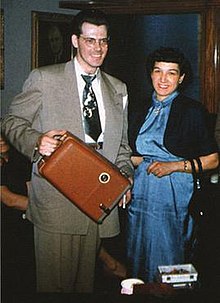Johnny Craig
| Johnny Craig | |
|---|---|
 Johnny Craig and his wife Toni at an EC Comics Christmas party in the early 1950s | |
| Born | John Thomas Alexis Craig April 25, 1926 Pleasantville, New York |
| Died | September 13, 2001 (aged 75) |
| Nationality | American |
| Area(s) | Writer, Artist |
| Pseudonym(s) |
|
| Awards | Will Eisner Award Hall of Fame, 2005 |
John Thomas Alexis Craig
Biography
Early life and career
Born in
EC Comics
Returning to comics after his discharge, he began drawing for
Craig later brought a clean, crisp,
In being a writer as well as an artist, Craig differed from the majority of EC artists. He was responsible for the stories hosted by the
Craig became the editor of The Vault of Horror early in 1954, giving up his work for Crime SuspenStories at that time. Later that year, he created the Vault Keeper's attractive assistant, Drusilla. After the EC horror books came to an end, Craig edited EC's Extra! in 1955, writing and drawing two stories in each bimonthly issue.
Craig's story "... And All Through the House" in Vault of Horror #35 (March 1954) was adapted for the
One critic wrote of his work:
Craig was a meticulous craftsman and not a fast worker, but his stories are regarded as some of the best ever in comics. His art was relatively low-key and restrained, effectively staged and featured impeccable draftsmanship. The scripts he wrote tended to be literate and cerebral, and generally relied on solid construction and implacable internal logic, rather than on contrived snap endings. His horror work made more use of psychology and mood than of the supernatural, and his crime comics owed more to
gangster movies.[8]
Later career
After EC's collapse in the wake of the United States Senate Subcommittee on Juvenile Delinquency hearings, Craig worked briefly for Atlas Comics, the 1950s predecessor of Marvel Comics, then spent several successful years at an advertising agency in Pennsylvania, though he lamented that his responsibilities there prevented him from drawing much.[9] He returned to comics in the 1960s with art for ACG's Unknown Worlds and other titles.
His resurfacing prompted Warren Publishing editor Archie Goodwin to have Craig draw for Warren's magazines from 1966 to 1968, during which time Craig (who still worked in advertising) used the pseudonym Jay Taycee, a phonetic pronunciation of his four initials. Of his attempts to work for DC Comics and Marvel Comics, however, comics historian Mark Evanier wrote,
By any name, the work was excellent, but Craig's efforts to work for the "big two" — DC and Marvel — were not as successful. In 1967, he applied at DC. Recalling the excellence of his EC stories, editor George Kashdan gave him an issue of The Brave and the Bold to draw — a Batman/Hawkman team-up. Craig handed the job in weeks late, whereupon his art was deemed too subdued, even for the relatively staid DC super-hero comics of the time. Before publication (in issue #70), the pages were heavily retouched and revised as to expunge any trace of Johnny Craig's style.[1]
Evanier wrote that Goodwin, by now writing for Marvel, said that, "Every so often, we'd try having him
By the early 1980s, Craig stopped drawing for comics and was semi-retired until his death in 2001. He did do many paintings of the Vault-Keeper, Drusilla and other E.C. horror themes, for private commissions, E.C. fanzines and other publications, and these works showed excellent technique in oils. His last known residences were Camp Hill, Pennsylvania, and Shiremanstown, Pennsylvania.[2]
Awards
Craig was posthumously inducted into the
References
- ^ a b c d Evanier, Mark (October 12, 2001). "Untitled". P.O.V. Online (column). Archived from the original on June 28, 2011. Retrieved September 24, 2011.
- ^ a b John T. Craig at the Social Security Death Index
- ^ a b c Hill, Roger. EC Archives: The Vault of Horror, Russ Cochran, Publisher/Gemstone, 2007, p. 42.
- ^ Lambiek Comiclopedia
- ^ a b Johnny Craig at the Grand Comics Database
- ^ ISBN 978-0-06-074698-8.
- ISBN 978-0-87805-975-1. Retrieved 2011-01-14.
- Science Fiction and Fantasy Writers of America. Archivedfrom the original on June 5, 2011. Retrieved September 24, 2011.
- ^ Geissman, p. 63
